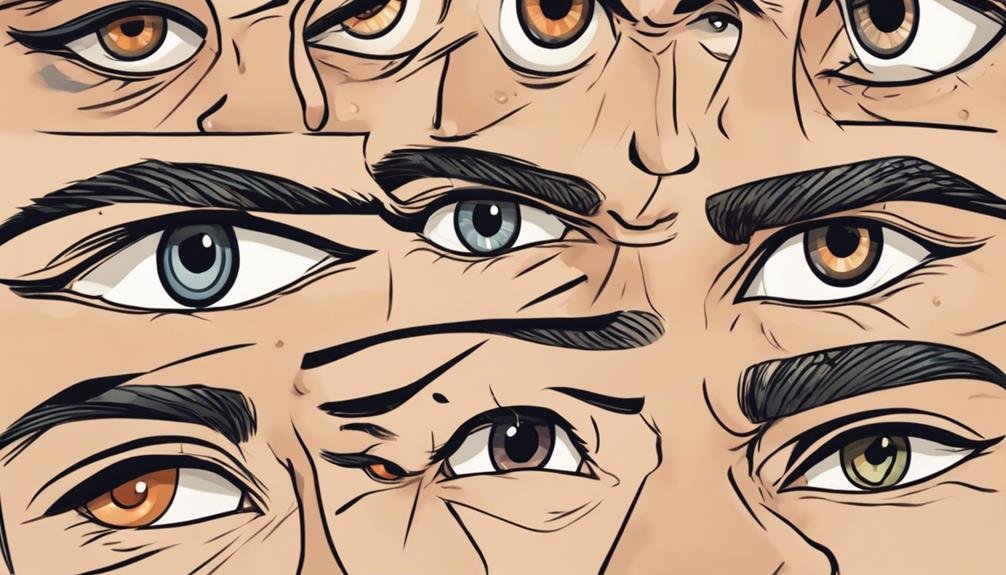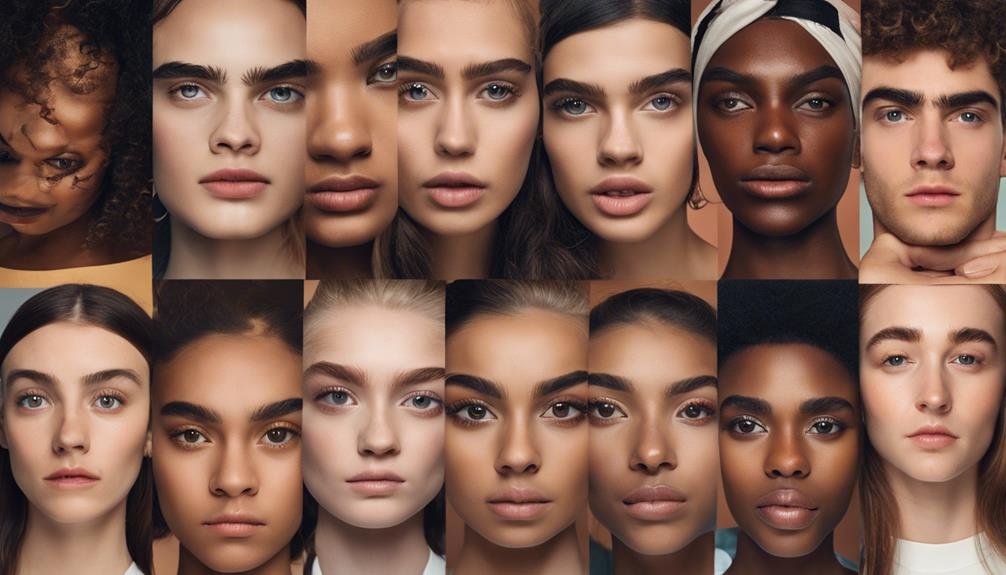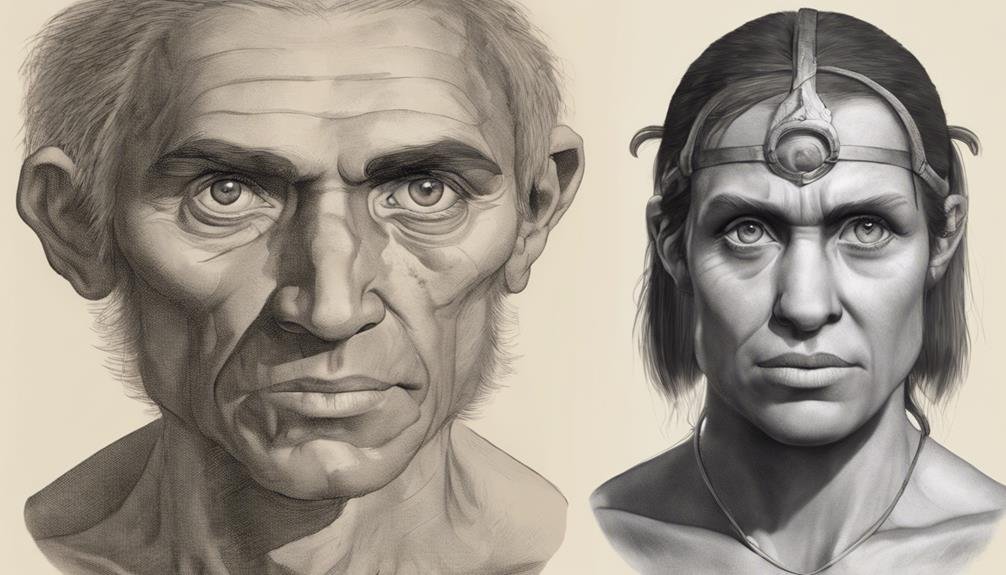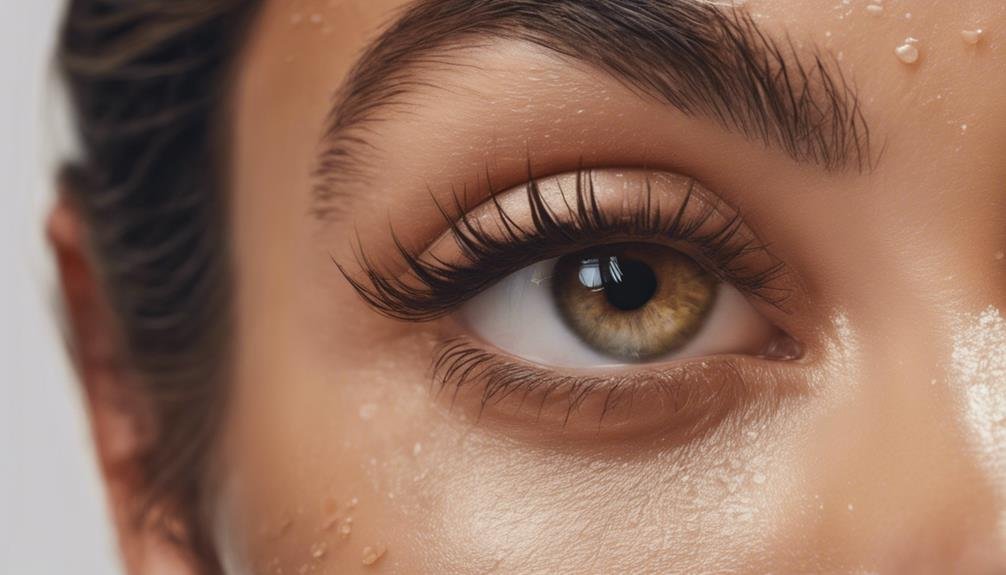Have you ever stopped to think about why you have eyebrows? Sure, they shape your face and enhance your expressions, but there’s more to them than meets the eye. Eyebrows play pivotal roles in protecting your eyes from sweat, dust, and sunlight, and they aid in nonverbal communication, helping you convey emotions without uttering a word. They even assist in facial recognition, making it easier for others to identify you. Are you curious about how these small patches of hair can be so multifaceted? Let’s explore the fascinating functions and significance of your eyebrows.
Key Takeaways
- Eyebrows divert sweat from the eyes, protecting them from moisture and bacteria.
- They convey emotions like anger, surprise, and happiness, aiding nonverbal communication.
- Eyebrows shield eyes from dust, debris, and sunlight, enhancing vision.
- They assist in facial recognition and identity, framing the eyes and enhancing expressions.
- Eyebrows reflect beauty standards and trends across cultures and personal grooming practices.
Eyebrows and Emotion

Eyebrows play a vital role in expressing a wide array of emotions, such as anger, surprise, happiness, and fear. You mightn’t realize it, but the subtle movements of your eyebrows can communicate powerful feelings without uttering a single word. Your eyebrows knit together when angry, creating a furrowed brow that instantly signals your displeasure.
On the flip side, when you’re surprised, your eyebrows shoot up, opening your eyes wide and conveying shock. The speed of your eyebrow movements also reflects different emotional states. Rapid, jerky movements might indicate anxiety or impatience, while slow, deliberate movements can suggest calmness or contemplation.
This dynamic range of motion makes eyebrows an essential component of nonverbal communication. Moreover, the position and shape of eyebrows greatly enhance facial recognition. Well-defined eyebrows can make facial expressions more distinct, aiding others in understanding your emotions more accurately.
Think about how an arched eyebrow can add a layer of skepticism or curiosity to your look. By mastering the art of eyebrow movement, you can convey a wealth of emotions and enhance your ability to connect with others on a deeper, more intuitive level.
Eyebrows as Protectors
You mightn’t realize it, but your eyebrows play an important role in protecting your eyes. They block sweat and moisture from dripping into your eyes, shield them from dust and debris, and even help reduce glare from the sun. This natural defense system keeps your eyes healthy and free from irritation.
Moisture Diversion Mechanism
Imagine running a marathon on a hot summer day; sweat pours down your face, yet your vision remains clear. That’s thanks to your eyebrows. These small but mighty features are essential in diverting moisture away from your eyes, ensuring you can see without irritation.
The curved shape of your eyebrows efficiently wicks away sweat, directing it towards the sides of your face rather than letting it trickle down into your eyes.
Eyebrows work hard to protect our eyes from sweat-borne dirt, bacteria, and other particles. When you sweat, these contaminants can easily mix with the moisture and cause eye irritation. Eyebrows act as a vital barrier, keeping these unwanted elements at bay. This not only preserves your vision but also maintains overall eye health.
Consider the benefits of eyebrows as moisture diversion mechanisms:
- Wick moisture away: The shape directs sweat away from the eyes.
- Protect our eyes: Prevents sweat-borne dirt and bacteria from entering.
- Cooling mechanism: Reduces the impact of sweat on your eyes.
- Natural barrier: Shields eyes from potential irritation.
Dust and Debris Shield
Think about walking down a windy street or riding a bike on a dusty trail; you hardly ever worry about particles flying into your eyes. That’s thanks to your eyebrows, which act as a protective shield. Their primary role is to form a barrier against dust, debris, and other particles that could harm your eyes. Arrows help maintain your vision and overall eye health by preventing these irritants from entering your eyes.
The curved shape of your eyebrows isn’t just for aesthetics; it’s highly functional. This shape helps wick away moisture, such as sweat, that could otherwise trickle down and cause eye irritation. Sweat often carries dirt and bacteria, spreading infections if they reach your eyes. Your eyebrows provide a natural defense mechanism, deflecting these sweat-borne contaminants and keeping your eyes safe.
Moreover, eyebrows act as a cooling mechanism. They help deflect foreign particles away from your eyes, ensuring you maintain clear vision even in challenging environments.
Sunlight and Glare Blocker
Eyebrows aren’t just for expression; they play an important role in shielding your eyes from sunlight and reducing glare. Your eyebrow hairs act like natural visors, providing a barrier that helps protect your eyes from direct sunlight. This is especially significant because harmful UV rays can cause considerable damage to your eyes over time.
Historically, before the invention of sunglasses, eyebrows served as a pivotal protection mechanism. The brow bone and the eyebrow hairs offer a physical defense against the sun’s brightness. Here’s how they help:
- Shield from Direct Sunlight: Eyebrow hairs block the sun’s rays, preventing them from hitting your eyes directly.
- Reduce Glare: Your eyebrows reduce glare by filtering the light, making it easier to see in bright conditions.
- UV Protection: The combination of the brow bone and hair provides a natural barrier against harmful UV radiation.
- Enhanced Vision: By limiting direct sunlight exposure, eyebrows help maintain clearer vision in bright environments.
Identity and Recognition

Eyebrows play a vital role in making your face uniquely yours, helping others recognize you instantly. Their thickness and position often signal gender, while changes due to aging can alter how you’re perceived. Understanding these features highlights why eyebrows are essential for identity and recognition.
Facial Feature Uniqueness
When you look at someone’s face, one of the first things that stands out is their eyebrows. These small clusters of hairs are more than just a facial accessory; they play an essential role in making each of us unique. Our eyebrows contribute significantly to our identity and are key in facial recognition. Imagine trying to remember someone without their distinct eyebrow shape or color—it would be challenging, right?
Eyebrows help in recognizing familiar faces and distinguishing individuals because they:
- Frame the eyes and enhance expressions
- They come in various shapes and colors
- Have unique thicknesses and positions
- Change with age, affecting recognition
Each eyebrow’s distinct characteristics—from the arch to the density of hairs—add to the diversity of human appearance. This diversity helps us identify individuals quickly and accurately.
For instance, the specific way your eyebrows arch or the shade they possess can make you instantly recognizable to friends and family.
Gender and Age Differentiation
Recognizing someone’s gender and age at a glance often hinges on subtle facial cues, and eyebrows play an essential role in this process. For gender differentiation, you typically notice that women have thinner and more arched eyebrows, whereas men tend to have thicker and straighter ones. These subtle differences help you quickly identify someone’s gender without needing any other context.
When it comes to age differentiation, eyebrows are equally significant. As people age, their eyebrows can thin out or change in color, affecting how you perceive their age. For instance, greying or sparse eyebrows might suggest an older individual, while fuller, darker brows are often associated with youth. These changes impact facial recognition, making eyebrows vital for identifying different age groups.
Moreover, eyebrows contribute to your unique identity and help distinguish you from others. Their shape, thickness, and color, influenced by genetics, make them easily recognizable to friends and family. Eyebrows also play a key role in non-verbal communication, expressing emotions like surprise or concern, further aiding social interactions.
Beauty and Culture
Throughout history, the importance of eyebrows in beauty standards and cultural practices can’t be overstated. They help us express emotions and contribute significantly to facial aesthetics. Eyebrows come in various shapes and sizes, reflecting the diverse beauty ideals across different cultures.
For example, ancient Egyptians often painted and darkened their eyebrows with kohl, while in medieval Japan, women shaved off their natural eyebrows and painted new ones higher on their foreheads.
Modern trends in eyebrow grooming have become equally varied and intricate:
- Tweezing: Precisely plucking hairs to achieve a desired shape.
- Waxing: Removing multiple hairs at once for a cleaner look.
- Dyeing: Coloring eyebrows to match or contrast with hair.
- Tattooing: Creating a permanent or semi-permanent look.
Your eyebrows can say a lot about you, helping to convey emotions and even aspects of your personality. You can accentuate your features and enhance your overall appearance with the right grooming techniques. Different cultures and eras have embraced unique eyebrow styles, showing how these small patches of hair play a big role in both beauty and cultural identity.
Eyebrow Evolution

Over millions of years, eyebrows have evolved to serve vital functions beyond mere aesthetics. Originally, they played a practical role by diverting moisture, such as sweat, away from your eyes. This natural barrier protected your vision from environmental debris and kept your eyes clear.
But eyebrows didn’t just evolve for physical protection. They also became essential tools for communication. Early hominins relied on their mobile eyebrows to express emotions and form social bonds. You can raise an eyebrow to show surprise or furrow them to signal confusion. This ability to convey emotions nonverbally enhanced social interactions and group cohesion.
The presence of eyebrow hair makes these expressions even more visible, facilitating emotional communication. This trait didn’t just benefit humans; dogs also evolved expressive eyebrows, which helped them communicate with humans. When a dog raises its eyebrows, it’s often trying to convey a feeling or need, making social interaction smoother and more intuitive.
Eyebrows also help you express various emotions, from anger to joy, making them indispensable in human interactions. So, while they add to your facial aesthetics, their primary functions are rooted in evolution and communication.
Eyebrow Genetics
When it comes to your eyebrows, much of what you see in the mirror is dictated by genetics. Specific genes determine characteristics like shape, color, and thickness. These inherited traits significantly affect how your eyebrow hairs grow and develop. You might notice that your eyebrows resemble those of your parents or grandparents, showcasing the hereditary nature of these features.
Genetics doesn’t work in isolation, though. Environmental factors can also influence your eyebrows. For example:
- Waxing or plucking: Frequent grooming can alter your eyebrows’ natural shape and appearance.
- Injuries: Accidents or surgeries near your eyebrows can disrupt hair growth patterns.
- Abnormalities: Conditions like madarosis, which leads to eyebrow loss, can be passed down through generations.
- Aging: Genetic and environmental factors may influence the density and color of eyebrow hairs as you age.
Understanding how your eyebrow hairs grow and what helps direct their development can provide insight into their unique appearance. While you can’t change your genetics, you can appreciate the genetic blueprint that shapes your distinct eyebrows, making them uniquely yours.
Eyebrow Care

Taking good care of your eyebrows is important for maintaining their shape and health. Regular grooming, whether through tweezing, waxing, or threading, helps keep your eyebrows neat and prevents abnormalities.
However, avoiding over-tweezing or over-waxing is vital, as this can lead to sparse regions that mightn’t grow back, permanently reducing your eyebrows’ natural fullness.
Seeking professional help for maintenance can be advantageous. Experts can shape your eyebrows to complement your facial features while guaranteeing minimal damage to the hair follicles. They also use proper techniques and tools to prevent skin irritation and potential long-term issues.
Understanding the genetic factors influencing your eyebrow traits can also guide your care routine. For instance, consulting a dermatologist can provide insights and treatment options if you’re prone to eyebrow hair loss or conditions like madarosis.
Effective eyebrow care isn’t just about aesthetics; it’s about maintaining the health of your hair and skin. By following a tailored grooming routine and seeking professional advice when needed, you can ensure your eyebrows look their best and stay healthy long-term.
Conclusion
Understanding why we have eyebrows can help us appreciate their multifaceted roles. Eyebrows help express emotions, shield our eyes from irritants, and make us more recognizable. They also reflect cultural beauty standards and tell a story of evolutionary adaptation. Recognizing their importance makes us more likely to care for them properly. So, keep grooming practices in mind and embrace the significance of your brows in function and beauty.
FAQs
What are the primary functions of eyebrows?
Eyebrows serve several important functions, both protective and expressive. One of their main roles is to protect the eyes from moisture, such as sweat and rain, by diverting it away from the eyes and towards the sides of the face. This helps to keep vision clear and prevents irritation. Additionally, eyebrows play a crucial role in nonverbal communication, allowing us to express a wide range of emotions through subtle movements, such as surprise, anger, or concern.
Key Functions:
- Protection: Diverts sweat and moisture away from the eyes.
- Expression: Enhances facial expressions and nonverbal communication.
How do eyebrows contribute to facial recognition?
Eyebrows are an essential feature in facial recognition, as they help define the contours of the face and contribute to our unique appearance. Studies have shown that eyebrows are a key factor in recognizing and remembering faces. Their shape, size, and position can significantly affect how we identify individuals, making them a critical element in distinguishing one person from another.
Facial Recognition:
- Defining Feature: Contributes to the unique appearance of each face.
- Identification: Plays a key role in recognizing and remembering people.
What is the evolutionary significance of eyebrows?
From an evolutionary perspective, eyebrows have developed to serve protective and social functions. As mentioned earlier, the protective role would have been crucial for early humans who spent much of their time outdoors, shielding their eyes from sweat, rain, and sun. Socially, the ability to convey emotions and intentions through eyebrow movement likely enhanced communication and cooperation among early humans, contributing to social bonding and survival.
Evolutionary Role:
- Protection: Helped early humans shield their eyes from environmental elements.
- Social Communication: Enhanced nonverbal communication and social interaction.

